How profitable could it be?
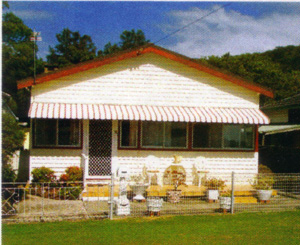
before
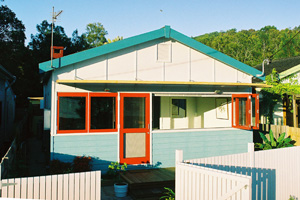
after
Everyone had reminded us that it's not easy making money from "investment renovating". Many had failed miserably, some tragically. We realized, however, that we had one advantage over most couples; only one of us held the title to our home. That meant the other could buy and sell another house in his or her name. For couples who like renovating for profit, having the title of your home in one name is a very favourable situation in which to be, and possibly one to work towards.
One of the main considerations was find a house in which one of us could live during (say) 9 months of renovation. Then, assuming sale and settlement took 3 months, it would be sold 12 months after purchase and capital gains tax would be halved.
This was at a crazy time (2004) when Australian house prices had been relentlessly rising for several years, but were expected to slow in the not too distant future. Whatever we did had to be done quickly, otherwise with a changing market, we could lose a lot of money.
We started looking at renovating opportunities near the bay side environment in which we lived. Staying in the area in which we had already built meant that we knew the local builders and could easily monitor forthcoming sales. The area was on a peninsula, 1.5 hours drive from Sydney and a 2 minute drive from the ocean. It was also surrounded by national park, so land was limited in availability. This was all good criteria, on paper, for a housing development project, but that would mean nothing if the market plunged.
Should we take on such a project?
We had no qualms about taking on DIWT (Do It With Trades) renovation, for we had previously owned a house and had it successfully deconstructed and renovated by a builder. We had designed those renovations ourselves and kept a careful eye on the entire building project. So we knew the process, there was no learning curve for us. Without some renovating experience we would have been foolish to take on an ambitious DIWT renovating project.
We were also two organized people; we were handy with basic building work and fortunately had an envious selection of power tools. However we knew our limitations. We knew that we would need specialist trades and a very good foreman.
To DA or not to DA
We found an old original fibro house for sale, a typically Australian "fisherman's cottage" - one of many originally built in the thirties with additions and alterations added over the subsequent decades. It was a run down assemblage of small boxy rooms, but it had an awesome aspect facing due north with 180 degree bay views. It was affordable because the land and surrounds were statistically flood prone (every 100 years) due to a creek than ran from an escarpment nearby. No development approvals (DA) were allowed in that area until a flood study had been done. Knowing the dismal speed at which the local council operated, that would take years, if not centuries.
Because of the small size and close proximity of the escarpment, we knew that any flooding would actually be quite minimal. The house was also on peers and the floor almost a meter off the ground. So even if there was a 1 in 100 year flood, it still wouldn't affect the house. Really there was no problem but still the council refused to consider a DA in that area.
The house needed a complete renovation however changing the layout, doors and window positions required a DA. We set about designing the renovations so that the footprint would remain the same, and the doors and windows, while changing radically in appearance, remained in exactly the same positions.
The bathroom and kitchen were so badly designed they really needed a complete reconfiguration. That however, would necessitate a change in plumbing which in turn required a DA. We saw, however, that with judicious design and a minimal compromise to ideal layouts, both bathroom and kitchen could be radically improved with minimal changes to the plumbing.
There appeared to be one minor structural change which required a DA. We wanted to open up the house, make the kitchen, living and sunroom all one room. We also wanted to see through the living space from one end of the house to the other; bay at one end, garden at the other. (This would also be great for airflow.) Therefore we had to remove a couple of half walls and install a new long timber support beam. On closer scrutiny we found that in fact, this new beam replaced two smaller beams. Because it could be argued that this was a replacement, not an addition, again the need for a DA could be avoided.
Most significantly there was no record of the interior floor plan on the original plumbing diagram. So when renovations were complete and a council inspection for a 149 certificate was done, no one would in fact know what the house was like before our renovation. (In fact the detail on a plumbing diagram, which is often the only official document of the house footprint, layout and services, is often the most important consideration in how much you can do without a DA.)
How much money to spend?
The house was advertised for $585,000 but no-one was interested because of the prohibition on DAs due to the alleged flood problem. We thought we could get the property for $550,000 and we did.
We estimated that the property after renovation would be worth about $900,000 if the current furious market persisted. We also estimated the renovations would cost $100,000 plus borrowing cost, legals ands insurance. Our net profit for a years part time work after all costs would depend on the selling price, but we hoped for about $100,000.
Cost effective renovating
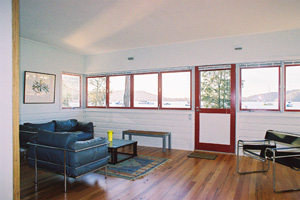
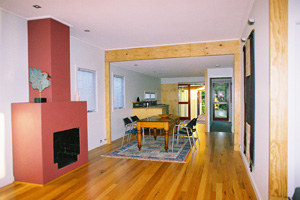
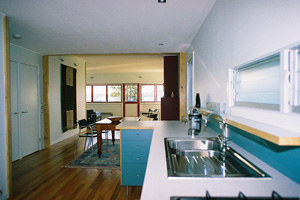
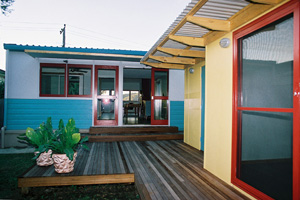
We paid a builder to look at the property to ascertain its structural integrity, and consider our proposed minor structural changes. He thought everything was achievable for the funds we had, provided we did as much work as possible ourselves, and were smart in the way we spent money.
So off we went. We very carefully selected and booked the key tradesman, a foreman carpenter who we knew would be on the job for most of the 3 months of full time building.
We hired two skips, one for the fibro interior cladding which had to be removed, and wrapped in plastic, and one for the other materials. We did the demolition ourselves, which took a few weeks.
At the same time we thought about the overall style we wanted. The house would remain traditional in outside appearance but inside we wanted it open plan, with a modern timber/beach feel. While the walls would be plasterboard, we wanted to expose as many of the timber beams as possible. In fact the timber beams became a signature design approach.
We finalised the design of the kitchen and bathroom, and researched new windows, particularly the front bay-facing windows which would be a feature of the house. We eventually selected bi-fold windows (see "after" picture above) that could be stacked in one corner and allowed the window space to be completely open. This proved to be a very smart decision because it made the house absolutely unique. We chose cedar window frames but painted them in high gloss deep red enamel - a colour that had been used back in the forties on original fishermans' cottages. The colour was perfect, both traditional and contemporary.
The floor was important - we knew it was the foundation for the look we wanted. We choose satin ash solid timber, but an inexpensive low grade, so that the variable detail of the timber (grain and knots) would be prominent. That also proved to be a good decision for besides being cost effective, the interesting detail and slightly pinkish colour of the timber added a lot of character to the house. It worked well with the red window frames and the fireplace that was later rendered to make it a feature and painted a complimentary colour. The decks were inexpensive, but good looking, Selangan Batu hardwood .
By swapping around rooms we were able to increase the size of the master bedroom. We installed built in wardrobes with floor to ceiling mirrors on the sliding doors which reflected the view.
The kitchen was a simple L-shaped configuration; the longer length against a wall, the shorter creating a breakfast bar. We positioned the stove in front of the existing small window to avoid needing a range hood. We drew up specifications for the kitchen and bathroom cabinetry ourselves and took those drawings to a local kitchen maker. We had inspected his warehouse which we observed as clean and highly organized, and his young fabricators a courteous and happy bunch. Once our kitchen man had acquired the benchtop material we had specified (which took two weeks) he built the simple kitchen off site in a few days and installed it in two days. As expected his work was impeccable, and his team a joy to work with. We bought all the appliances from the one supplier and received a discount.
We had the new shower area waterproofed which was totally uneventful. Funny but water-proofer's never seem to have a sense of humour. The plumber was fine, and did great work even when stoned out of his head. He anticipated everything that needed to be done, turned up when he said he would, and was forever smiling and humming his way through the day. Every fitting was perfectly installed. We knew the local council plumbing inspector knew him (and his indiscretions) but considered him a good tradesperson who never made mistakes. (While local inspectors won't provide a recommendation for plumbers, you can usually read if they approve of them.)
We gave the tiler very specific instructions to ensure that the grouting lined up, which he didn't like doing, but did it all the same. (They usually never bother with lining up grouting which requires much more thought and precision but can make a huge difference to the appearance.) We withheld total payment until we could ensure that the water gurgled nicely into the waste, which it did. We choose a rimless shower screen to create more sense of space and put in a bath as well as a shower, because we thought that new buyers may have young children. We also designed a bathroom cabinet that floated off the floor, ran the mirror across the full width of the room, and concealed the cistern, all of which created more sense of space. We choose simple, stylish, but inexpensive basins and tap-ware.
Then there was the electrician. Cripes, what a mistake. We had a recommendation from a builder to use this particular person but forgot to ask his rate before he started, and to find out if he worked alone or with an offsider or apprentice. This guy thought we had lots of money, (which we didn't), so he decided to charge us $65 an hour. (I later found his normal rate was much lower.) He also came with a motivationally challenged mate who knew nothing about electrics but charged $45 an hour! They thought they were king of the trades. But when finished they couldn't see that almost every power point they had installed was crooked and of course charged us for straightening them!
Finally the renovating was complete. It was a clockwork job with no mistakes, no hold ups, and we did in 6 months. The cottage looked extraordinary, and the neighbours were gobsmacked at the speedy transformation from an old boxy broken down cottage to an inviting, open plan beach house. It was a contemporary but sympathetic take on a piece of traditional Australian architecture.
In the end we spent $105,000 on renovations. The market however, had slowed significantly and we didn't get our anticipated $900,000 sale price, but $825,000. (As expected the buyer was not at all concerned about the flood statistics. He also had children and wanted a bath in the bathroom!) We made $80,000 profit which meant that we were paid satisfactory wages for the duration of the project.
Would we do it again?
We probably would do it again with a similar property in the same area. Apart from the electrician, it was mostly a hassle free, enjoyable renovation where we made a little money. Could someone without building experience have done such a big job? Probably, but not without a builder on the job - and that would have added $40,000 to the costs. We knew that we could design and project manage the renovating job ourselves. We also knew what we had to subcontract certain work. When DIY renovating, it is important to recognize your limitations, otherwise mistakes start creeping into the equation. And every mistake costs money.

